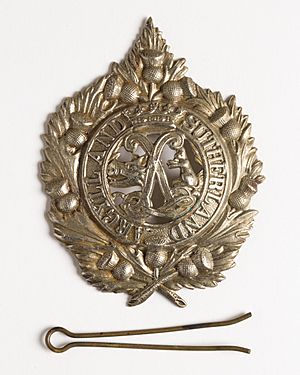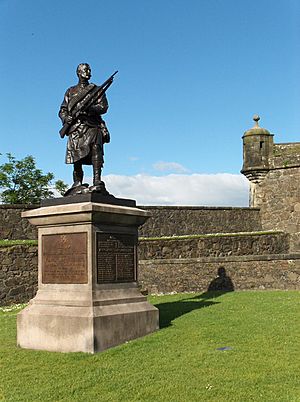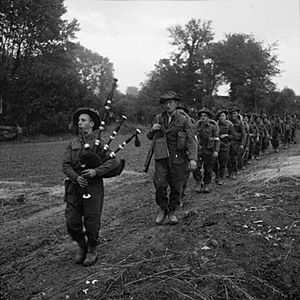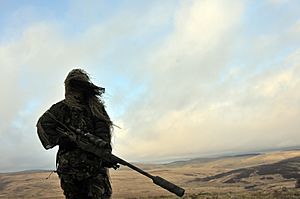Argyll and Sutherland Highlanders facts for kids
Quick facts for kids Argyll and Sutherland Highlanders (Princess Louise's) |
|
|---|---|

Cap badge
|
|
| Active | 1 July 1881 – present |
| Country | |
| Branch | |
| Type | Line infantry |
| Role | Light Infantry Company / SCPD |
| Size | One reinforced company |
| Garrison/HQ | RHQ – Stirling Castle Company – Redford Barracks |
| Nickname(s) | Thin Red Line |
| Motto(s) | Ne Obliviscaris, Sans Peur |
| March |
|
| Mascot(s) | A Shetland Pony named "Cruachan" |
| Anniversaries | Balaklava (25 October 1854) |
| Commanders | |
| Ceremonial chief | King Charles III |
| Insignia | |
| Tactical Recognition Flash |  |
The Argyll and Sutherland Highlanders (Princess Louise's) was a famous line infantry regiment of the British Army. It existed from 1881 until 2006. Today, it is a special light infantry company called Balaklava Company. This company is part of the 5th Battalion, Royal Regiment of Scotland.
The regiment was formed in 1881. It combined two older regiments: the 91st (Argyllshire Highlanders) and the 93rd (Sutherland Highlanders). During the First World War, the regiment grew to fifteen battalions. In the Second World War, it had nine battalions. The 1st Battalion fought in the Korean War. It also became well-known for its role in Aden in 1967.
In 2006, the Argyll and Sutherland Highlanders joined other Scottish regiments. They all became part of the new Royal Regiment of Scotland. Later, in 2012, the 5th Battalion was made smaller. It became the single light infantry company we know today as Balaklava Company.
Contents
History of the Argyll and Sutherland Highlanders
How the Regiment Started
The regiment was created in 1881. This happened because of new army rules called the Childers Reforms. It combined the 91st and 93rd Regiments. The Argyll and Sutherland Highlanders was one of six Scottish infantry regiments. They wore a special tartan called the Sutherland district tartan. Their cap badge was the biggest in the British Army.
Even before it was officially formed, the 93rd Regiment was famous for its bravery. This was especially true during the Crimean War. There, the 93rd earned the nickname "The Fighting Highlanders." They also became known as the original "Thin Red Line."
This name came from the Battle of Balaklava on 25 October 1854. A single battalion of the 93rd stood alone. They faced four groups of charging Russian cavalry. The 93rd, led by Sir Colin Campbell, held their ground. They stopped a large cavalry charge using only musket fire. This was the first time this had happened in British Army history.
A newspaper reporter, William Howard Russell, saw this brave act. He wrote that only a "thin red streak tipped with a line of steel" stood against the Russians. This phrase quickly became "The Thin Red Line." It came to represent the courage of the British Army. Today, the regiment's cap still has red and white squares. These squares remind everyone of this famous moment.
Fighting in the Second Boer War

The 1st Battalion arrived in Cape Colony in November 1899. They were part of the Highland Brigade. The Argylls played important roles in several battles. These included the Battle of Modder River and the Battle of Magersfontein. They also fought in the Battle of Paardeberg.
In 1908, the army changed how it was organized. The regiment then had two Reserve and five Territorial battalions.
The First World War
During the First World War (1914–1918), many battalions of the Argyll and Sutherland Highlanders fought.
Regular Army Battalions
- The 1st Battalion went to the Western Front in December 1914. They were part of the 27th Division.
- The 2nd Battalion also went to the Western Front in August 1914. They were part of the 19th Brigade.
Territorial Force Battalions
- The 1/5th Battalion fought at Cape Helles in June 1915. They later moved to Egypt and then back to the Western Front.
- The 1/6th Battalion landed in France in May 1915. They were part of the 51st (Highland) Division. They also fought in Italy before returning to France.
- The 1/7th Battalion arrived in France in December 1914. They were part of the 4th Division.
- The 1/8th Battalion fought in France from May 1915. They were also part of the 51st (Highland) Division.
- The 1/9th Battalion landed in France in February 1915. They were part of the 27th Division.
New Army Battalions
- The 10th Battalion went to the Western Front in May 1915. They were part of the 9th (Scottish) Division.
- The 11th Battalion arrived in France in July 1915. They were part of the 15th (Scottish) Division.
- The 12th Battalion landed in France in September 1915. They later moved to Salonika.
- The 14th Battalion went to the Western Front in June 1916. They were part of the 40th Division.
The Second World War
The Argyll and Sutherland Highlanders played a big part in the Second World War (1939–1945).
1st Battalion's Journey
The 1st Battalion fought in many places. They were in the Western Desert Campaign and on the island of Crete. They also fought in Abyssinia, Sicily, and the Italian Campaign. Their first battle was at Sidi Barani in December 1940.
On Crete, they helped defend the island. Many were captured when the island surrendered. The battalion was later sent to Alexandria. After some duties there, they fought in the Second Battle of El Alamein. In 1943, they landed in Sicily. From February 1944, they fought through the Italian Campaign.
2nd Battalion in Malaya and Singapore
The 2nd Battalion fought bravely against the Imperial Japanese Army. This was during the fighting in Malaya and Singapore. They were led by Lieutenant Colonel Ian Stewart. He made sure his soldiers were ready for jungle warfare. They trained in the toughest areas. This training made them very effective. They were even called "the jungle beasts."
The 2nd Argylls slowed down the Japanese advance. They caused heavy losses to the enemy. But the battalion lost many soldiers. They were ordered back to Singapore. When they arrived, they were joined by Royal Marines. These Marines had survived the sinking of HMS Prince of Wales and HMS Repulse. The combined group was sometimes called "Plymouth Argylls."
The battalion surrendered with the rest of the army in Singapore in February 1942. Many Argylls became POWs. Some managed to escape to India. There, they taught others about jungle warfare.
In May 1942, a new 2nd Battalion was formed. This battalion joined the 15th (Scottish) Infantry Division. This division became very well-known. They fought in the Battle for Caen as part of Operation Overlord. The division ended the war on the Elbe River.

Other Battalions in WWII
- The 5th Battalion was part of the British Expeditionary Force in France in 1939. They took part in the Dunkirk evacuation. Later, they became the 91st Anti-Tank Regiment. They fought in the Normandy landings and through North-West Europe.
- The 6th Battalion also joined the British Expeditionary Force in 1939. They were part of the Dunkirk evacuation. They then became the 93rd Anti-Tank Regiment. They saw action in Tunisia, Sicily, and Italy.
- The 7th Battalion was a Territorial Army (TA) unit. They were part of the 51st (Highland) Infantry Division in France in 1940. They avoided being surrounded at Dunkirk. But they suffered heavy losses. The division was later reformed. In 1942, the new 51st Division, including the 7th Argylls, joined the British Eighth Army in North Africa. They fought in the First Battle of El Alamein and the Second Battle of El Alamein. These battles changed the course of the war. Lieutenant Colonel Lorne MacLaine Campbell of the 7th Argylls won the Victoria Cross in North Africa.
- The 8th Battalion was also a TA unit. They served with the 7th Battalion. They were evacuated from France in 1940. In 1943, the 8th Battalion gained fame during the attack on Djebel Ahmera hill. This was part of the attack on Longstop Hill in Tunisia. Major John Thompson McKellar Anderson won the Victoria Cross for his bravery there.
- The 9th Battalion, another Territorial unit, became an artillery unit. It was the 54th Light Anti-Aircraft Regiment. They used Bofors guns. They helped protect the retreat to Dunkirk. After D-Day in August 1944, they supported the First Canadian Army. They fought through northern France and into Belgium and Holland. They stayed in Holland until the end of the war.
After the Wars
Between 1945 and 1948, the 1st Battalion served in Mandatory Palestine. They were involved in conflicts there.
In 1948, the 2nd Battalion joined with the 1st Battalion. This combined battalion was one of the first British units in the Korean War. They arrived in September 1950. They were known for their reoccupation of the Crater district of Aden in the 1960s. This was during the Aden Emergency.
In 1970, the Argyll and Sutherland Highlanders faced being disbanded. But a "Save the Argylls" campaign helped. A compromise was reached. A single regular company, "Balaclava Company," kept the regiment's name and traditions. This company continued as a separate unit. The regiment was restored to full battalion size in 1972. From 1972 to 1974, parts of the regiment served in Northern Ireland during the Troubles. In January 2004, the regiment went to the Iraq War.

On 28 March 2006, the Argyll and Sutherland Highlanders joined other Scottish infantry regiments. They formed the single Royal Regiment of Scotland. Before this, the regiment's last role was in the air assault role. This meant they could be quickly moved by air.
The 5th Battalion of the new Royal Regiment of Scotland continued to recruit in the Argylls' area. They wore a green feather on their cap. They were allowed to use the title "The Argyll and Sutherland Highlanders."
On 5 July 2012, more changes were made to the British Army. The Argyll and Sutherland Highlanders (5 SCOTS) was reduced to a single company. This is the Balaklava Company we know today. It performs public and ceremonial duties in Scotland. The Queen visited the Highlanders in June 2013. This was to mark their move to Scotland.
Today, when the company performs royal guard duties, it has two platoons. One is for ceremonial duties, and one is for security. When not on guard duty, the company has two platoons for regular deployments. The company is now based at Redford Barracks. It is part of the 51st Infantry Brigade and Headquarters Scotland.
Regimental Museum
The Argyll and Sutherland Highlanders Regimental Museum is located in Stirling Castle. The museum building was built in the 1490s. It was known as the "King's House." It is thought to have been the private home of King James IV. You can visit the museum with your castle entrance ticket. The museum relies on public donations to operate. It closed for improvements in August 2018. It reopened in June 2021 after a big renovation.
Battle Honours
The regiment has earned many battle honours. These are special awards for bravery in battles. Some of their honours include:
- Cape of Good Hope 1806, Rolica, Vimeira, Corunna, Pyrenees, Nivelle, Nive, Orthes, Toulouse, Peninsula, South Africa 1846–47, 1851–52–53, Alma, Balaklava, Sevastopol, Lucknow, South Africa 1879, Modder River, Paardeberg, South Africa 1899–1902.
- The Great War – Mons, Le Cateau, Retreat from Mons, Marne 1914, 18, Aisne 1914, La Bassée 1914, Messines 1914, 18, Armentières 1914, Ypres 1915, 17, 18, Gravenstafel, St Julien, Frezenberg, Bellewaarde, Festubert 1915, Loos, Somme 1916, 18, Albert 1916, 18, Bazentin, Delville Wood, Pozières, Flers-Courcelette, Morval, Le Transloy, Ancre Heights, Ancre 1916, Arras 1917,18, Scarpe 1917, 18, Arleux, Pilckem, Menin Road, Polygon Wood, Broodseinde, Poelcappelle, Passchendaele, Cambrai 1917,18, St Quentin, Bapaume 1918, Rosières, Lys, Estaires, Hazebrouck, Bailleul, Kemmel, Bethune, Soissonnais-Ourcq, Tardenois, Amiens, Hindenburg Line, Epehy, Canal du Nord, St Quentin Canal, Beaurevoir, Kortrijk, Selle, Sambre, France and Flanders 1914–18, Italy 1917–18, Struma, Doiran 1917, 18, Macedonia 1915–18, Gallipoli 1915–16, Rumani, Egypt 1916, Gaza, El Mughar, Nebi Samwil, Jaffa, Palestine 1917–18.
- The Second World War– Somme 1940, Odon, Tourmauville Bridge, Caen, Esquay, Mont Pincon, Quarry Hill, Estry, Falaise, Dives Crossing, Aart, Lower Maas, Meijel, Venlo Pocket, Ourthe, Rhineland, Reichswald, Rhine, Uelzen, Artlenburg, North-West Europe 1940, 44–45, Abyssinia 1941, Sidi Barrani, El Alamein, Medenine, Akarit, Diebel Azzag 1942, Kef Ouiba Pass, Mine de Sedjenane, Medjez Plain, Longstop Hill 1943, North Africa 1940–43, Landing in Sicily, Gerbini, Adrano, Centuripe, Sicily 1943, Termoli, Sangro, Cassino II, Liri Valley, Aquino, Monte Casalino, Monte Spaduro, Monte Grande, Senio, Santerno Crossing, Argenta Gap, Italy 1943–45, Crete, Heraklion, Middle East 1941, North Malaya, Grik Road, Central Malaya, Ipoh, Slim River, Singapore Island, Malaya 1941–42.
- Korean War – Pakchon, Korea 1950–51.
Victoria Cross Recipients
- Lance Corporal J. Dunlay, 16 November 1857, Indian Mutiny
- Captain W.G.D Stewart, 16 November 1857, Indian Mutiny
- Private P. Grant, 16 November 1857, Indian Mutiny
- Private (later Sergeant) D. MacKay, 16 November 1857, Indian Mutiny
- Colour-Sergeant J. Munro, 16 November 1857, Indian Mutiny
- Sergeant J. Paton, 16 November 1857, Indian Mutiny
- Lieutenant (later Major-General) W. McBean, 11 March 1858, Indian Mutiny
- Capt J.A. Liddell 31 July 1915 Belgium
- Lieut J.R.N. Graham 22 April 1917 Mesopotamia
- 2nd Lieut A. Henderson MC 23 April 1917 France
- 2nd Lieut J.C. Buchan 21 March 1918 France
- Lieut D.L. MacIntyre 24–27 Aug 1918 France
- Lieut W.D. Bissett 25 October 1918 France
- Lieut Col L.M. Campbell, DSO, TD 6 April 1943 Wadi Akarit
- Major J.T. McKellar Anderson, DSO, TD 23 April 1943 Longstop Hill
- Major K. Muir 23 September 1950 Korea
Colonels-in-Chief
- 1914–: HRH Princess Louise, Duchess of Argyll
- 1947–2006: HM Queen Elizabeth II
Affiliations
The regiment has special connections with other military units:
 Canada – The Argyll and Sutherland Highlanders of Canada (Princess Louise's)
Canada – The Argyll and Sutherland Highlanders of Canada (Princess Louise's) Canada – The Calgary Highlanders
Canada – The Calgary Highlanders Canada – Cape Breton Highlanders
Canada – Cape Breton Highlanders Australia – The Royal Queensland Regiment
Australia – The Royal Queensland Regiment Australia – The Royal New South Wales Regiment
Australia – The Royal New South Wales Regiment Pakistan – 1st Battalion (Scinde), The Frontier Force Regiment
Pakistan – 1st Battalion (Scinde), The Frontier Force Regiment Royal Navy – HMS Argyll
Royal Navy – HMS Argyll United Kingdom – Balaklava Company, West Lowland Battalion ACF
United Kingdom – Balaklava Company, West Lowland Battalion ACF
See Also
- Notable members of the Argyll and Sutherland Highlanders






